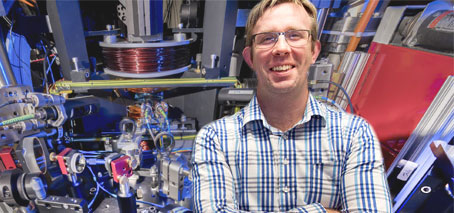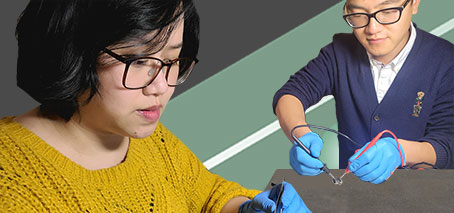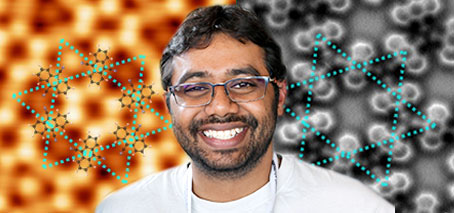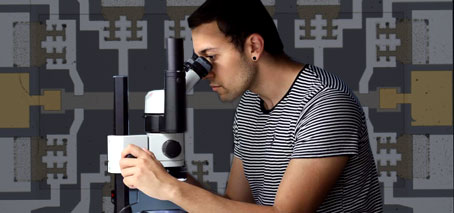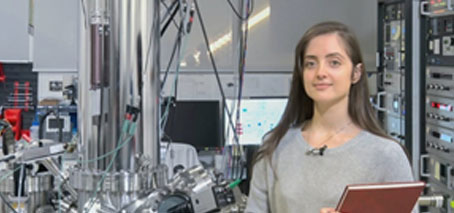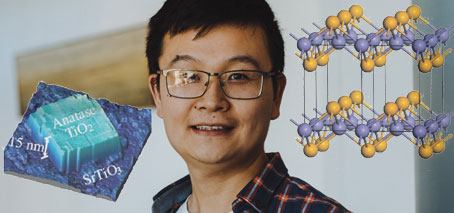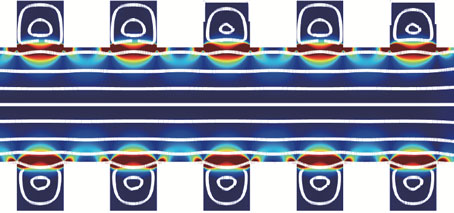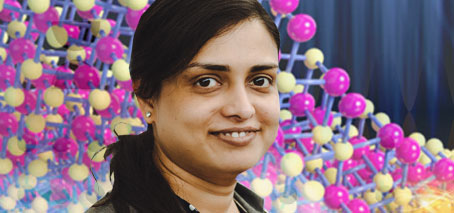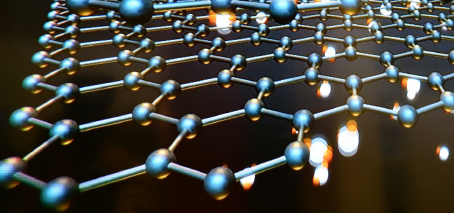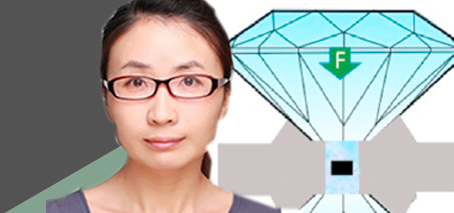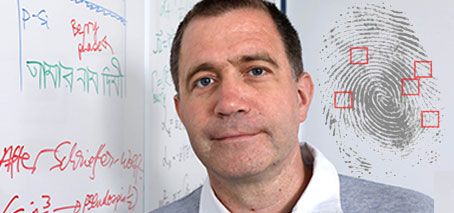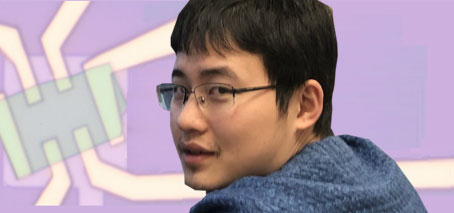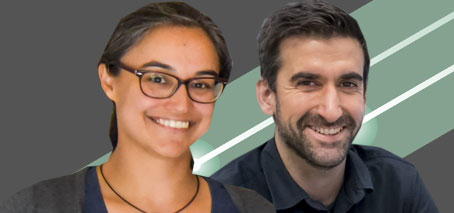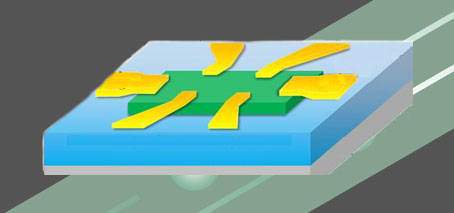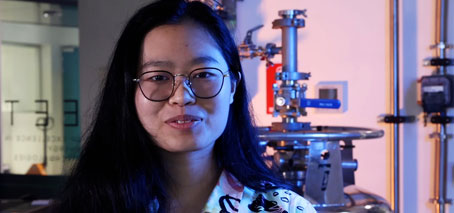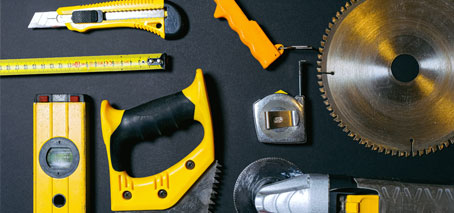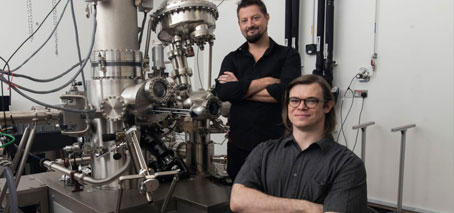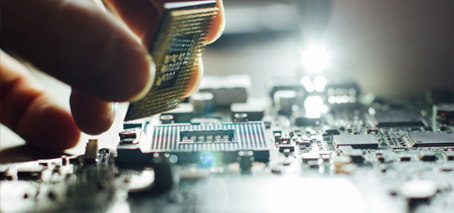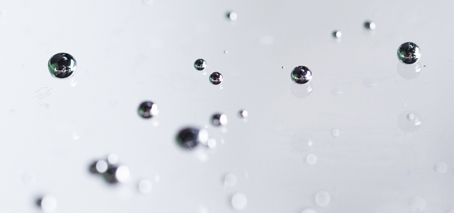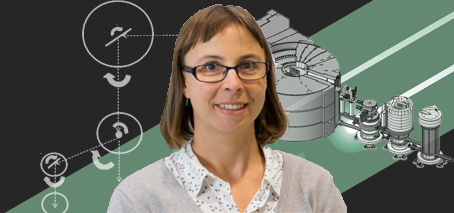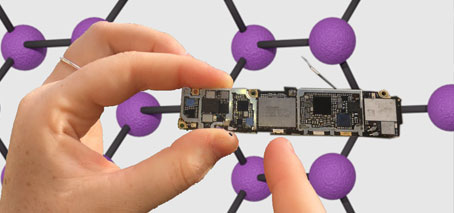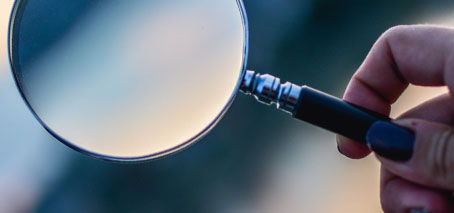Exotic phase transitions unlock pathways to future, superfluid-based technologies. We can learn a lot by studying microscopic and macroscopic changes in a material as it crosses from one phase to another, for example from ice to water to steam. But while these phase transitions are well understood in the case of water, much less is known about the dynamics when …
Electrons on the edge: the story of an intrinsic magnetic topological insulator
An intrinsic magnetic topological insulator MnBi2Te4 has been discovered with a large band gap, making it a promising material platform for fabricating ultra-low-energy electronics and observing exotic topological phenomena. Hosting both magnetism and topology, ultra-thin (only several nanometers in thickness) MnBi2Te4 was found to have a large band-gap in a Quantum Anomalous Hall (QAH) insulating state, where the material is …
Star attraction: magnetism generated in 2D organic material by star-like arrangement of molecules
2D kagome materials are a platform for tuneable electron-electron interactions ‘Star-like’ atomic-scale kagome geometry ‘switches on’ magnetism in a 2D organic material A 2D nanomaterial consisting of organic molecules linked to metal atoms in a specific atomic-scale geometry shows non-trivial electronic and magnetic properties due to strong interactions between its electrons. A new study, published today, shows the emergence of …
Home-grown semiconductors for faster, smaller electronics
‘Growing’ electronic components directly onto a semiconductor block avoids messy, noisy oxidation scattering that slows and impedes electronic operation. A UNSW study out this month shows that the resulting high-mobility components are ideal candidates for high-frequency, ultra-small electronic devices, quantum dots, and for qubit applications in quantum computing. Smaller means faster, but also noisier Making computers faster requires ever-smaller transistors, …
¡Felicidades! Fellowship success for Dr Iolanda Di Bernardo
Congratulations to FLEET Research Fellow Dr Iolanda Di Bernardo (Monash), who has received the highly prized Juan de la Cierva fellowship to fund research in Spain, starting in Spring 2022. The Juan de la Cierva fellowship is highly competitive, with a success rate between 10 and 15%, and is similar to the Australian DECRA fellowship. The grants encourage the recruitment …
Congratulations Dr Zhi Li, a superconducting Future Fellow
Congratulations to FLEET AI Dr Zhi Li (UOW) who received an ARC Future Fellowship in this month’s announcement. The new ARC Fellowship will support Dr Li’s study of iron-based high-temperature topological superconductors, based at the Institute of Superconducting and Electronic Materials (ISEM) at the University of Wollongong. The topological non-trivial nature and zero resistance of topological superconductors make them very …
Where are they now? Life Post-FLEET with Paul Atkin
Talk to as many people as possible about your future career Stay open to new career directions Hi, I’m Paul Atkin. If we didn’t meet during my time as a FLEET scientist, we may have met more recently in my new life as a sales guy. If we haven’t met yet, I sincerely apologise and strongly suggest we meet for …
A Smooth Conduit for Electron Fluids
—first published APS Physics Electrons flow like a viscous fluid through a 2D channel with perfectly smooth sidewalls, offering a new platform to test solid-state and fluid dynamics theories. Electrons can, under certain conditions, flow like a fluid that’s thicker than honey. Now researchers have managed to observe this viscous fluid behavior in a way that allows unambiguous measurements and …
Mixing a cocktail of topology and magnetism for future electronics
Monash review: joining topological insulators with magnetic materials for energy-efficient electronics A new Monash review throws the spotlight on recent research in heterostructures of topological insulators and magnetic materials. In such heterostructures, the interesting interplay of magnetism and topology can give rise to new phenomena such as quantum anomalous Hall insulators, axion insulators and skyrmions. All of these are promising …
New 2D research hub features FLEET talent
A new ARC Research Hub highlighting the role of novel and 2D materials in emerging technologies in fields such as energy storage, purification and printed electronics features FLEET talent amongst its team. The ARC Research Hub for Advanced Manufacturing with 2D Materials (AM2D) will be led by Prof Mainak Majumder (Monash Department of Mechanical Engineering). Two FLEET Chief Investigators are amongst …
Video explainers for 3MT
Tackling the next climate crisis with polariton superfluids, chocolate bars, ultra-fast laser pulses and chaotic gardening… FLEET’s Rishabh Mishra (Swinburne), Mitko Oldfield and Alex Nguyen (both at Monash University) have recently recorded explanations of their PhD research, submitted for the 2021 national Three Minute Thesis competition. Mitko Oldfield (School of Physics and Astronomy) explains his studies of polariton superfluids, with …
Reviewing pressure effects on iron-based high-temperature superconductors
Fe-based superconductors reviewed The discovery of iron-based superconductors with a relatively high transition temperature Tc in 2008 opened a new chapter in the development of high-temperature superconductivity. The following decade saw a ‘research boom’ in superconductivity, with remarkable achievements in the theory, experiments and applications of iron-based superconductors, and in our understanding of the fundamental mechanism of superconductivity. A UOW …
Identifying a topological fingerprint
Generating a topological anomalous Hall effect in a non-magnetic conductor anomalous planar Hall effect (APHE) the ‘smoking gun’ for the topological magnetic monopole in momentum space A FLEET theoretical study out this week has found a ‘smoking gun’ in the long search for the topological magnetic monopole referred to as the Berry curvature. This discovery is a breakthrough in the …
Transforming the layered ferromagnet Fe5GeTe2 for future spintronics
Realizing in-situ magnetic phase transition in metallic van-der-Waals magnet Fe5GeTe2 via ultra-high charge doping A RMIT-led international collaboration published this week has achieved record-high electron doping in a layered ferromagnet, causing magnetic phase transition with significant promise for future electronics Control of magnetism (or spin directions) by electric voltage is vital for developing future, low-energy high-speed nano-electronic and spintronic devices, …
Congratulations Meera Parish and Agustin Schiffrin
Congratulations to two of FLEET’s Chief Investigators, whose contributions have recently been recognised by the School of Physics and Astronomy at Monash University: Meera Parish promoted to full Professor Agustin Schiffrin promoted to Associate Professor Prof Meera Parish (right) is a theoretical physicist developing many-body theories that span electron-hole systems and ultracold atomic gases. She is an ARC Future Fellow …
Inducing and tuning spin interactions in layered material by inserting iron atoms, protons
Controlling Dzyaloshinskii-Moriya interaction (DMI) in chiral magnet iron-doped tantalum-sulfide by proton intercalation Magnetic-spin interactions that allow spin-manipulation by electrical control allow potential applications in energy-efficient spintronic devices. An antisymmetric exchange known as Dzyaloshinskii-Moriya interactions (DMI) is vital to form various chiral spin textures, such as skyrmions, and permits their potential application in energy-efficient spintronic devices. Published this week, a Chinese-Australia …
Creative, online lab demonstrations maintain international collaborations
How does global research collaboration work, while Covid-19 still prevents international in-lab visits? A recent FLEET collaboration found a creative solution, running in-lab demonstrations of new quantum technologies across multiple universities on two continents. FLEET’s Matthias Wurdack (ANU) and Semonti Bhattacharyya (Monash) were able to consult with researchers in the New York lab of FLEET PI Jim Hone (Columbia University), …
Women in FLEET Honours students at RMIT, UNSW, ANU
Please welcome FLEET’s three new Women in FLEET Honours students: Kyla Rutherford (RMIT) Olivia Kong (UNSW) Robin Hu (ANU) Kyla, Olivia and Robin have all received Women in FLEET Honours Scholarships, which are awarded to high performing students doing their Honours research project with FLEET. Kyla Rutherford will be working with Jared Cole at RMIT to understand transport properties in …
Tools of the Trade: Iolanda Di Bernardo explains XPS depth profiling for Nature series
X- ray photoelectron spectroscopy (XPS) is used for material characterization, providing quantitative information on the chemical composition of materials by identifying the type of elements that are present (nowadays, with a detection limit in the range of one part per thousand). XPS also allows the identification of the chemical state of the elements – such as the types of bonds …
Electrons on the edge: Atomically-thin quantum spin Hall materials
An exotic class of topological quantum materials has been reviewed by an international team of physicists, led by A/Prof Bent Weber at Nanyang Technological University (NTU – Singapore). Atomically-thin quantum spin Hall insulators, whose electronic states are protected by topology, promise applications in quantum information processing. Quantum spin Hall insulators are a class of two-dimensional (2D) topological states of matter …
Tools of the Trade: Eli Estrecho explains laser trapping for Nature series
A ‘pumped’ laser can be used to trap and manipulate an exciton-polariton condensate. These quantum fluids, which can behave as a resistanceless superfluid in certain conditions, need continuous replenishing, with the pumping laser supplying both a reservoir of electrons and confining force. “The pumping laser can trap the quantum fluid as the particles are repelled from the pump region, similarly …
Topological-switching patents demonstrate FLEET’s dominance in field
Two patent applications, one filed in 2020, reinforce FLEET’s position as a world leader in topological transistors. The patents cover work in the ‘switching’ of topological material, to facilitate creation of a functioning topological transistor – a proposed new generation of ultra-low energy electronic devices. Their world-first success was the switching of a material via application of an electric-field between …
Liquid metals spin-off launched
The Liquid-metals spin-off company Liquid Metal Plus (LM+) initiated in 2020 with FLEET investigators Kourosh Kalantar-Zadeh (UNSW) and Dr Torben Daeneke (RMIT), together with Dorna Esrafilzadeh (UNSW), was launched in April 2021. Pushing print on flexible touchscreens Climate rewind: turning CO2 back into coal The company has two areas of focus, with the unifying theme being application of liquid-metal technologies …
Explainer: Linkage funding for topological-thermoelectricity
A team led by FLEET CI Prof Xiaolin Wang (University of Wollongong) has won a linkage project for topological materials based thermoelectricity. Thermoelectricity can directly convert heat to electrical energy or vice-versa. It plays an important role in renewable and sustainable energy by harvesting waste heat, which is widely available in human body, computer chips, sunlight and steel industry. Thermoelectric …
Thermoelectric devices convert waste heat from industry into viable new energy source
New research supports development of thermoelectric devices to convert waste heat from industry into a viable new energy source Australian industries could benefit from being able to harness the heat by-products from operations Development of advanced materials can sustainably convert waste heat into useful forms of energy to benefit Australia. The work will be undertaken as part of an Australian …
Topological materials beat Boltzmann’s tyranny: Surpassing lower limit on computing energy consumption
Topological insulators can reduce transistor switching energy by a factor of four Defeating Boltzman’s tyranny, which puts a lower limit on operating voltage New FLEET research confirms the potential for topological materials to substantially reduce the energy consumed by computing. The collaboration of FLEET researchers from University of Wollongong, Monash University and UNSW have shown in a theoretical study that …
Tools of the Trade: Zengji Yue explains ion intercalation for new Nature series
Inserting ions into, or between, atomically-thin materials can be used to alter their properties in a finely-controlled fashion. For example, graphene’s properties can be fine-tuned by injection of another material (a process known as ‘intercalation’) either underneath the graphene, or between two graphene sheets. (See article.) “Intercalating ions into layered materials increases the spacing and decreases the coupling between the …
A new, positive approach could be the key to next-generation, transparent electronics
A new study, out this week, could pave the way to revolutionary, transparent electronics. Such see-through devices could potentially be integrated in glass, in flexible displays and in smart contact lenses, bringing to life futuristic devices that seem like the product of science fiction. For several decades, researchers have sought a new class of electronics based on semiconducting oxides, whose …
Qubits comprised of holes could be the trick to build faster, larger quantum computers
New study indicates holes the solution to operational speed/coherence trade-off, potential scaling up of qubits to a mini-quantum computer. Quantum computers are predicted to be much more powerful and functional than today’s ‘classical’ computers. One way to make a quantum bit is to use the ‘spin’ of an electron, which can point either up or down. To make quantum computers …
‘Target identified’: teaching a machine how to identify imperfections in 2D materials
Applying machine learning to automated characterisation of atomically-thin materials Just as James Cameron’s Terminator-800 was able to discriminate between “clothes, boots, and a motorcycle”, machine-learning could identify different areas of interest on 2D materials. The simple, automated optical identification of fundamentally different physical areas on these materials (eg, areas displaying doping, strain, and electronic disorder) could significantly accelerate the science …

